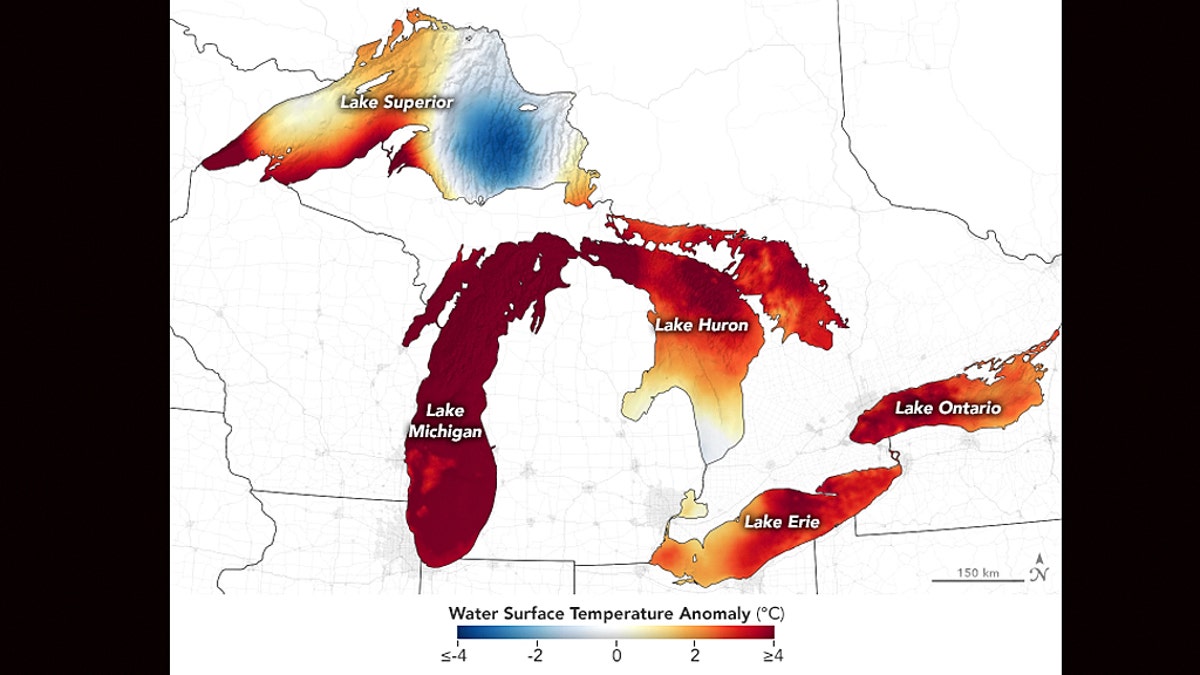National forecast for Thursday, July 16
Fox News senior meteorologist Janice Dean has your FoxCast.
If you're looking to cool off from the summer heat across the Midwest, get prepared for some rather warm water in the Great Lakes.
Weeks of persistent hot temperatures have allowed the Great Lakes to "warm significantly" in the summer sunlight.
"The recent hot temperatures and fairly light winds have sent the temperatures of the lakes soaring above normal," the National Weather Service (NWS) office in Gaylord, Mich., tweeted earlier this month.
SEVERE WEATHER, TORNADO RISK FOR LOWER GREAT LAKES; HOT TEMPERATURES SPREAD NORTHWARD
Data from the National Oceanic and Atmospheric Administration's (NOAA) Great Lakes Environmental Research Laboratory (GLERL) shows that all five lakes are much warmer than usual this time of year.
Near-shore temperatures along Lake Superior have been around 60 to 68 degrees Fahrenheit, while areas of Lake Michigan have been in the lower 70s in northern Michigan and in the upper-70s closer to Chicago.
But in Lake Erie, places near Toledo have been described as "basically bathwater."
According to a map from NASA and NOAA reports from over the weekend of July 10-12, water temperatures for beachgoers in the shallower coastal areas of lakes Michigan, Huron, Erie and Ontario ranged from 75 to 85 degrees. The only area below normal was the eastern portion of Lake Superior.
HEAT WAVES HAVE BECOME MORE FREQUENT AND INTENSE IN MOST OF THE WORLD SINCE 1950S: STUDY
Jia Wang, a climatologist at the NOAA Great Lakes Environmental Research Laboratory, noted that a lack of winter ice cover and early melting allowed layering of warm water to form on the lakes, keeping cooler water from rising.

Water surface anomalies are seen on the Great Lakes in this imagery from NASA. (NASA)
“Then the surface water gets warmer,” Wang said. “This is a seasonal positive feedback between the stratification and the surface water temperature.”
Data from NOAA shows the Great Lakes typically reach their peak surface temperatures in August, or later.
CLICK HERE FOR MORE WEATHER COVERAGE FROM FOX NEWS
In addition to the warm water, lake levels have also risen to unusually high levels in some places.
In May 2020, lakes Erie, Michigan, and Huron set records for water heights, according to the Army Corps of Engineers.
CLICK HERE FOR THE FOX NEWS APP
While the water temperatures are high, scientists believe that Lake Erie's annual blob of pea-green algae is expected to be smaller this summer than a year ago following a relatively dry spring.
NOAA said last week the algae bloom on the shallowest of the Great Lakes will reach 4.5 on its severity index — a “moderate” reading. That's lower than last year's 7.3 rating but higher than the 3.8 measured in 2018.
“A smaller bloom forecast for Lake Erie and the surrounding coastal communities is encouraging, but we cannot be complacent,” said Nicole LeBoeuf, acting director of NOAA’s National Ocean Service.























